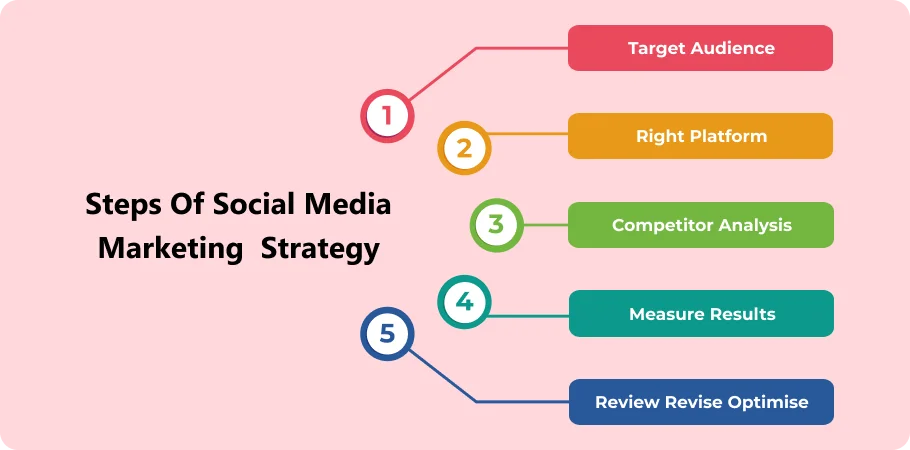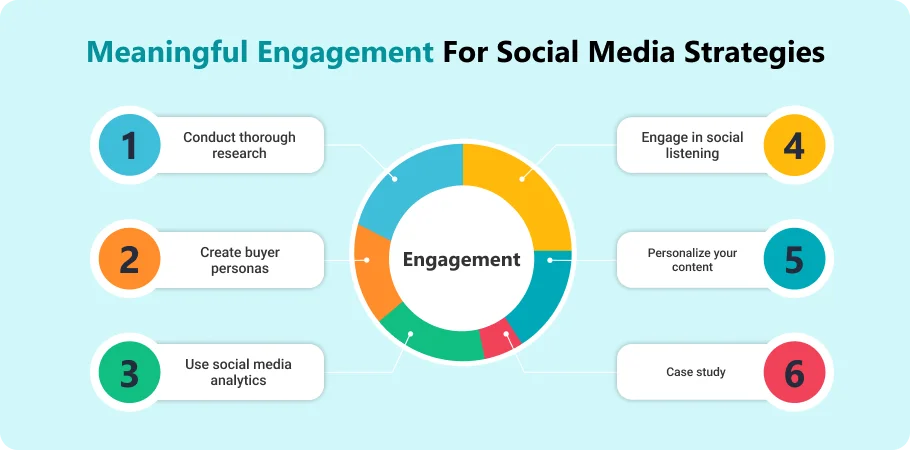Welcome to our blog on creating a winning social media marketing strategy for 2025! In today’s fast-paced digital world, businesses rely on social media platform to connect with their public, build brand awareness, drive sales, and foster meaningful customer relationships. As the online world changes, businesses must adjust and leverage their own social strategy to remain relevant and practical.
Throughout this guide, we’ll cover many topics, including setting clear objectives, understanding your target audience, creating content using relevant keywords, choosing the proper social channels to nurture maximum engagement, analyzing metrics to measure success, and incorporating social listening. Whether your goal is to increase brand awareness, generate leads, drive traffic, or boost sales, our step-by-step approach will provide the guidance you need to create a successful social media management strategy.
So, if you’re ready to elevate your social media marketing presence, connect with your audience on a deeper level, and unlock the full potential that social media platforms offer, let’s dive in and start creating a winning ecommerce strategy that sets you apart!
Social Media Management Strategy

A social media management strategy functions like a game plan for businesses, providing clarity on their actions and objectives. To begin with, it establishes social media marketing goals, whether it’s increasing brand awareness, driving website traffic, or boosting product sales. This ensures alignment across the team. Next, it involves understanding the target audience deeply – their demographics, preferences, and online hangouts. This knowledge allows businesses to tailor their messages effectively. Choosing the right social media management platform, such as Facebook, Instagram, or Twitter, is crucial; a social strategy helps determine where to focus efforts for optimal outcomes.
Once the strategy is in place, the focus shifts to creating compelling contents that resonates with followers. This could range from engaging videos to informative tips or exclusive behind-the-scenes insights. Interacting actively with followers is equally vital. Responding promptly to comments, soliciting feedback, and initiating discussions fosters a loyal community. Monitoring performance metrics is facilitated by the strategy, enabling businesses to leverage social media effectively, invest in paid advertising to extend their reach, and achieve specific digital marketing strategy objectives, such as boosting sales.
Analytics and Tactics of social media strategy
A good social media strategy also means leveraging analytics to adjust and refine. By looking at engagement rates, follower growth and conversion rates regularly you can see what’s working and what’s not. This data driven approach means you can adjust in time so your social media is aligned to your overall marketing goals. And staying up to date with the latest trends and platform updates is key to keeping your strategy relevant and effective. By combining these analytics with regular reviews and updates to your strategy you can have a dynamic and responsive social media presence’s and drive long term growth and success.
Steps of Social Media Marketing Strategy

Step 1: Define Your Goal for Social Media Strategy
Determining your fundamental goal is the first step in creating a successful social media management plan or strategy. Think about your marketing strategy, business objectives, and the importance of your business name in your social media marketing efforts. Do you want to get more people to know about your brand? Drive more traffic to your website? Get people to buy your products or services. Connect with your audience in a meaningful way.
For example, you want to increase’s brand awareness, marketing, and business goals. In that case, a social marketing strategy might aim to reach a certain number of people with your marketing posts. If you want to drive more traffic to your website, you might aim to get a certain percentage of people who see your posts to click through.
Whatever goals you set, make sure they’re SMART: specific, Measurable, Achievable, Relevant, and Time-bound. It will help you stay focused and ensure you’re making progress towards your objectives.
Tip: When defining your goals for your social media strategy, remember to make them SMART: Specific, Measurable, Achievable, Relevant, social space and Time-bound. It ensures that your objectives are clear, trackable, aligned with business goals, and have a deadline for achievement. By setting SMART goals, you’ll stay focused and be able to measure your progress effectively.
Step 2: Conduct Audience Research for Social Media Strategy

Your social media team will identify your target market, allowing you to choose the proper channels and create content that relates to your audience with the appropriate messaging, voice, and tone. Define your audience by determining the demographics of the people who need or want your product or service. Consider age, location, education, income, occupation, marital/relationship status, education level, and other vital attributes.
Next, define the buyer personas within your audience. These are representations of your actual customers within the market segment you serve. Use psychographics to identify core characteristics, interests, behaviors, personalities, attitudes, values, lifestyles, behaviors, and purchasing motivations. Then, develop messaging and content tailored to critical personas.
Let’s continue with our e-commerce example. Research shows that your social media users consist primarily of millennial women aged 25-34 interested in sustainable fashion and handmade products. With this information, you can customize your content to connect with your audience by showcasing the eco-friendly features of your jewelry and sharing stories about your artisans’ work behind the scenes.
Tip: When conducting audience research for your social media strategy, focus on understanding your target audience and what they care about. Consider their age, location, and income demographics, but also delve deeper into their interests, values, and motivations. By creating detailed buyer personas, you can customize your messaging and content to resonate with your audience’s preferences and needs, ultimately increasing engagement and driving results.
Step 3: Choose The Right Social Media Platforms

Now that you’ve determined your goals, the marketing team will decide where you want to be on social media. Choosing the right social media management tools for your business can take time and effort with many platforms. But don’t worry—we’re here to help you make the best choices.
Think about your audience and where they spend their time online. Are they on Facebook, Instagram, Twitter, LinkedIn, TikTok, or even Snapchat? Each platform has strengths and audience demographics, so picking the ones that align with your goals and where your audience hangs out the most is essential.
For example, platforms like Instagram and TikTok might be your best bet if you’re targeting a younger audience. However, if you’re in a more professional industry, LinkedIn could be a better fit. And if you’re targeting a broad audience, Facebook is always a safe choice.
Once you’ve chosen your platforms, it’s essential to make sure you’re using them effectively. That means posting regularly and sharing audience-related content on social media channels. So, take some time to research your options and choose the best social media channels for your business. You’ll be well on your way to social media marketing success with the right choices!
Tip:
- When selecting platforms for your business, focus on where your audience spends their time online.
- Consider platforms like Facebook, Instagram, LinkedIn, or TikTok based on your target demographics and industry.
- Focus on quality rather than quantity – excelling on a few platforms is more important than spreading yourself too thin across many.
- Once you’ve chosen your platforms, ensure consistent posting and engagement to maximize your presence and connect effectively with your audience.
Step 4: Establish Your Social Media Presence

Now that you know what you want to achieve with your social media marketing strategy, it’s time to start building your presence on social CRM platform. It means setting up accounts where your target audience hangs out.
Start by choosing the right platforms for your business. Think about where your audience is most likely to be. Are they on Facebook, Instagram, Twitter, or LinkedIn? Once you’ve identified the platforms your audience uses, create social accounts for the same. When setting up your accounts, make sure they reflect your brand identity. Use your logo and brand colors in your profile picture, and write a bio that explains who you are and what you do. It will help people recognize your brand and understand what you’re all about.
Once your accounts are set up, post content that resonates with your audience. Share updates about your business, behind-the-scenes peeks, helpful tips and advice, and anything else that might be interesting or useful to your followers. Be sure to use hashtags and tags to make your posts more discoverable. As you build your following, engage with your audience by answering comments and messages, liking and sharing their social posts, and asking for feedback. It will help you build a loyal community of followers interested in your words.
Establishing a solid social media presence’s will allow you to reach more people, build brand awareness, and ultimately achieve your goals. So don’t wait—start building your online presence today!
Tip: Select the best social CRM for your audience, craft profiles that mirror your brand, and share content that connects with them. Interact by replying to comments and messages and using hashtags to boost visibility. Establishing a solid presence requires dedication and persistence, so keep at it.
Step 5: Develop a Content Strategy for Social Media Channel

Now that you know what you want to achieve with your social media marketing strategy, it’s time to think about what you will share. Developing a content strategies involves figuring out what kind of posts you’ll create, how often you share them, and what topics you’ll cover.
Start by thinking about your audience and what interests them. What kind of content will they find valuable or entertaining? They may like seeing behind-the-scenes photos of your business or prefer helpful tips and tricks related to your industry.
Consider how often you’ll post once you know what your audience likes. Will you share something every day, a few times a week, or only occasionally? Consistency is critical here, so choose a posting schedule to follow.
Creating a social media content calendar is helpful to ensure consistency and organization. This calendar will outline what content you plan to post on which days and times, helping you stay on track with your strategy.
Finally, think about what topics you’ll cover in your posts. Using a social media content calendar, one can ensure that you consistently share valuable and engaging posts that resonate with your audience while driving your e-commerce goals forward. So, take some time to think about what type of content is best for your audience and your e-commerce strategy, and start creating!
Tip:
- Know your audience and what they like to see. Create a posting schedule.
- Use a content calendar to stay organized. Plan your content ahead of time to ensure consistency and relevance.
Step 6: Craft Compelling Content for Social Media Content Strategy

Now that you know who you’re talking to and what you want to say, it’s time to get creative and create excellent content! Captivating content grabs people’s attention and keeps them coming back for more. It’s what makes your social media posts stand out in a sea of updates and capture the hearts and minds of your audience.
When creating content for social media, think about what your audience wants to see and how you can provide value to them. Whether it’s entertaining videos, informative articles, or inspiring images, ensure your content is engaging and relevant to your audience’s interests.
One way to create engaging content is to tell stories. People love stories because they’re relatable and memorable. Share behind-the-scenes of your business, highlight customer success stories, or highlight the people behind your brand. Sharing stories will humanize your brand and build a deeper connection with your audience.
Finally, experiment with different formats to see what resonates best with your audience. Whether you use short videos, long-form articles, or eye-catching graphics, mix things up and keep your content fresh and exciting.
So, roll up your sleeves and get ready to create excellent content that will wow your audience and keep them coming back for more!
Tip:
- When crafting content for social media, keep your audience at the top of your mind.
- Create engaging posts that provide value through entertainment, information, or inspiration.
- Share relatable stories, embrace authenticity, and experiment with different formats to keep it fresh and exciting.
Book a CrmOne Demo
Experience the CrmOne simplicity and power. Our experts will show you the best ways to use it and answer your questions in real time. See how CRMOne fits your needs.

Step 7: Amplify Meaningful Engagement for Social Media Strategies

Now that you’re active on social media, it’s time to engage with your audience meaningfully, including monitoring the CTA. It means more than just posting content—it’s about creating conversations and building relationships.
One of the best ways to do this is by responding to your followers’ comments, messages, and mentions. When someone takes the time to engage with your content, it’s essential to acknowledge them and show that you value their input. It could be as simple as liking their comment or replying thoughtfully.
Another way to encourage engagement is to ask questions and solicit feedback from your audience. People love to share their opinions, so allow them to do so! You could ask for input on new products or services, views on industry trends, or even their thoughts on a recent post.
Finally, remember to celebrate your followers and show appreciation for their support. Whether through shoutouts, giveaways, or exclusive discounts, finding ways to reward your audience for their loyalty can go a long way toward building a solid community around your brand.
By fostering meaningful interactions with your audience and monitoring the customer satisfaction score, you’ll strengthen your relationships with existing customers and attract new ones drawn to your engaged and interactive online presence. So, feel free to get creative and start engaging with your audience in a way that feels authentic and genuine to your brand!
Tip: Track your customer satisfaction and engage on social media. Reply to comments, seek feedback, and appreciate your followers with shoutouts or giveaways. Connecting with your audience boosts loyalty and attracts new customers.
Step 8: Monitor and Analyze Key Metrics for Social Media Strategy

Once your strong social media strategy is in place, your social team will monitor its progress. That means paying attention to specific numbers or metrics that tell you if your efforts are paying off.
- Clicks: This tells you how often people click on your posts or ads to learn more. It’s an excellent way to see if your content catches people’s attention and drives them to act.
- Impressions: This shows how often people see your posts or ads. Knowing how many eyeballs are on your content is helpful, even if they’re not clicking on it.
- Engagement: This shows how much people engage with your content by liking, commenting, or sharing it. High engagement means your content connects well with your audience.
- Reach: It tells you how many unique users are seeing your content. It’s similar to impressions but focuses on individual users rather than total views.
- Conversions:This measures the number of people who take the desired action, like signing up or making a purchase, after seeing your social media content.
Tracking social media metrics can help you better understand your strategy’s successes and failures. You can then use this information to adjust and improve your approach over time.
So, ensure you regularly check in on these critical numbers and use them to guide your social media efforts. It’s essential to ensure that your strategy is effective and helping you reach your goals.
Tip: Monitor metrics such as clicks, engagement, and conversions to understand the success of your social media strategy. Use this information to improve your approach and your results over time.
Step 9: Conduct Competitive Analysis

Now, it’s time to examine your competitors’ social media activity. This step involves exploring what other businesses in your industry are doing and determining how you can improve your efforts.
Start by making a list of your competitors. Once you have your list, hop on their social media pages and look around.
Please pay attention to how often they post, what content they share, and how they interact with their followers. Are they getting a lot of likes and comments? Are they running any special promotions or campaigns?
Analyzing your competitors’ social media activities will help you better understand what works and what doesn’t in your industry. It can also help you develop new ideas for your social media strategy and stay one step ahead of the competition.
But remember, the goal here isn’t to copy what your competitors are doing—it’s to learn from them and find ways to differentiate yourself. So, use what you’ve learned to improve your social media presence!
Tip: Monitor your competitors’ social media activities closely to gain valuable insights for your strategy. Look for trends, engagement tactics, and content formats that resonate with their audience and adapt them to fit your brand’s unique voice and goals. While learning from competitors is essential, always strive to differentiate yourself and offer something unique to your followers.
Step 10: Optimize and Iterate

The final step in your social CRM plan is to keep improving and aiming for social media success. After you’ve set everything up and started posting, it’s essential to see what’s working and what’s not. This way, you can make changes and keep improving over time.
For example, if you notice that certain types of posts get more likes and shares, try to do more of those. If your audience responds better to videos than photos, focus on making more videos. If posting at certain times of the day gets better results, adjust your schedule accordingly.
It’s also a good idea to monitor your competitors’ strategies. See what’s working for them, and consider how to adapt it to your social media strategy.
Social media constantly changes, so staying flexible and experimenting is essential. Keep trying new things, learning from successes and failures, and adjusting as needed. By staying agile and open-minded, you’ll be able to keep growing and improving your social media presence for years to come.
Tip:
- Regularly monitor your social media performance and adapt accordingly for optimal results.
- Identify what types of posts co-relate with your audience, whether videos, images, or text, and prioritize creating more of that content.
- Stay informed about your competitors’ strategies and consider how to incorporate successful tactics into your approach.
Conclusion
In conclusion, creating a winning social media marketing strategy requires an approach that integrates various elements to achieve business objectives effectively. CrmOne is a solution that streamlines this process. By following the ten steps above, businesses can confidently navigate the dynamic landscape of social networks. Each step is crucial for success, from setting social media goals to developing a content strategies and fostering meaningful engagement.
Social media managers are pivotal in executing the strategy, leveraging actionable insights, paid media, and key performance indicators to optimize performance across multiple platforms. Embracing user-generated content and finding their brand voice is essential to enhancing social presence and maximizing engagement. Investing in advertising spend and developing a robust e-commerce strategy can further amplify reach and impact, helping to drive traffic and effectively promote brands in today’s competitive social network environment.
Get started for Free
Start for free today. Boost your sales by clicking the Get Started button. With CrmOne, you can manage leads, sales, and customer service all in one place.
